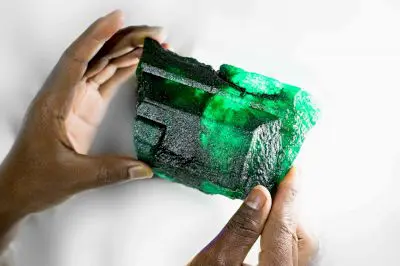Synthesized type of fluxIn this method, synthetic emeralds grown in the laboratory are melted and can have impurities such as fingerprints, but in larger dimensions, and also traces of the flux process appear in them

Gem dealers play a crucial role in ensuring the authenticity of Gemstones they sell. They have a responsibility to accurately represent the gemstones to their customers and provide assurance regarding their origin and quality. Being able to distinguish between natural emeralds and fake emeralds helps them maintain their reputation and uphold ethical standards. Natural emeralds, especially those of high quality and rarity, can be valuable investments. Gem dealers need to accurately assess and price gemstones based on their authenticity and quality. Mistakenly selling a fake Emerald as a natural one can lead to financial losses for both the dealer and the buyer. Therefore, gem dealers should possess the expertise to identify genuine emeralds to protect the interests of all parties involved.
Gem dealers who can confidently differentiate between natural and fake emeralds demonstrate professionalism and expertise in their field. This expertise enhances their reputation and credibility among customers, fellow professionals, and the industry at large. Natural emeralds often exhibit a unique and vibrant green color. Look for rich, deep greens with a hint of blue or yellow undertones. Synthetic emeralds may sometimes appear too perfect or have an overly saturated or uniform color. Natural emeralds commonly contain characteristic inclusions, such as tiny fractures, known as jardin. These inclusions are often visible to the naked eye and can resemble moss or vegetation. In synthetic emeralds, the absence of such inclusions or the presence of consistent and repetitive patterns may suggest an artificial origin.
Emerald Stone was produced artificially until 1840, but today it is presented in a synthesized form. It is very difficult to distinguish the natural type from the centered one and it requires a lot of knowledge and experience. The Stones that may be offered instead due to similarity are: dementoid, diopside, dioptase, grossular (chromium green garnet).
- Synthetic Emerald Types
The first artificial crystal was made in 1848 by A.W. Vernoy was produced in a laboratory, and its production technique has evolved to this day. - Synthetic type of Lenix
These synthesized Rocks grow in the form of rectangular crystals and not hexagonal prisms. Their optical refractive index is slightly lower than normal. - Synthesized hydrothermal emerald
Characteristic impurities include feathers of biphasic liquids and microscopic cuneiform crystals and elongated floating growth structures. - Synthesized type of flux
In this method, synthetic emeralds grown in the laboratory are melted and can have impurities such as fingerprints, but in larger dimensions, and also traces of the flux process appear in them. - Synthesized regenerative type
These samples were synthesized using the original Linde method and the carbide union method. They have the same light refractive index as normal, although their specific gravity is slightly lower at 2.68.
Natural emeralds can have varying degrees of clarity, ranging from almost transparent to heavily included. Synthetic emeralds, on the other hand, are typically grown in controlled environments, resulting in higher clarity and fewer inclusions. If an emerald appears flawless or has no visible inclusions under magnification, it might be a synthetic stone. Natural emeralds can exhibit growth patterns and crystal structures that indicate their natural formation. Synthetic emeralds may show growth patterns that are too perfect or uniform, lacking the natural irregularities found in genuine stones.
Many natural emeralds undergo treatments to improve their appearance or clarity. Common treatments include the use of oils or resins to fill surface-reaching fractures. If a seller discloses that an emerald has been treated, it does not necessarily mean it is synthetic. However, heavily treated emeralds or those with unnatural clarity should be examined more closely. If you are unsure about the authenticity of an emerald, it is best to seek the opinion of a qualified gemologist or a professional gem-testing laboratory. These experts have the knowledge and specialized equipment to conduct thorough examinations and provide an accurate assessment.
Customers rely on gem dealers for their expertise and guidance in purchasing gemstones. By being able to differentiate between natural and fake emeralds, gem dealers can provide accurate information to customers, answer their queries, and address any concerns they may have. This builds trust and confidence in the dealer's knowledge and integrity, fostering long-term relationships with customers. Gem dealers stay up-to-date with the latest developments and trends in the Gemstone market. This includes being aware of new synthetic or treated gemstones that may be introduced to mimic natural emeralds. By staying informed and continuously learning, gem dealers can adapt to changing market dynamics and accurately identify the latest imitation techniques or synthetic materials used to create fake emeralds.





